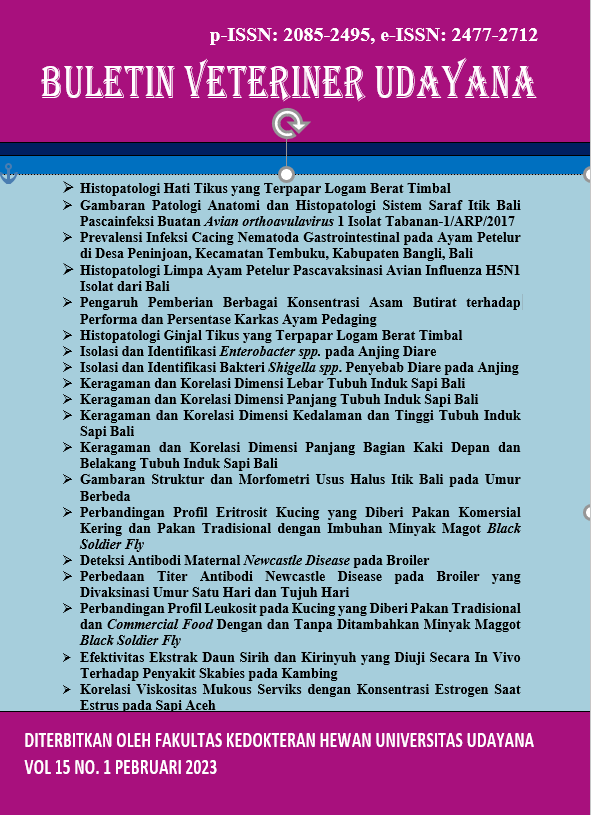HISTOPATHOLOGY OF RAT KIDNEY EXPOSED TO LEAD HEAVY METAL
Abstract
Lead is a non-essential heavy metal which is toxic to kidney, carcinogenic, and teratogenic if get inside animal or even human’s body. The research aims to determine the histopatologic view of rat’s kidney which was exposed to lead with different doses. The research uses 20 of 2 months old Wistar strain white rat with 250-300 g body weight. The research uses completely randomized design with 4 treatments, which is control (P0), 0.5 ppm lead acetate (P1), 1.0 ppm lead acetate (P2), and 2.0 lead acetate (P3). Treatment were given daily for 30 days and on day 31 euthanation and necropsy was performed then the kidney tissue was removed and put into 10% neutral buffer formalin. Then histopathologic preparation with hematoxilyn eosin stain was made. Kidney histopathology changes that were examined were bleeding, necrosis, and inflammation. Severity of the lesion was made into scoring wiith mild category of it was focal, moderate if it was multifocal, and severy if it was diffuse. The Kruskal-Wallis test of the histopathologic examination result of rat’s kidney which was exposed to lead acetate shows a significant bleeding, necrosis and even nephritis (inflammation) lesion compared to without the exposure to lead acetate (control). The Mann-Whitney test shows a significant result which varies between bleeding, necrosis, even nephritis (inflammation) lesion. with a It can be concluded that the administration of lead acetate with the dose of 0.5 ppm, 1.0 ppm, even 2.0 ppm can cause bleeding, necrosis even nephritis compared to control and the administration of 2.0 ppm dose shows the most severe lesions. There needs to be a continued research regarding the effects of lead with higher doses.
Downloads
References
Ayala A, Muñoz MF, Argüelles S. Lipid peroxidation: production, metabolism, and signaling mechanisms of malondialdehyde and 4-Hydroxy-2-Nonenal. Oxid. Med. Cell. Longev. 2014: 360-438.
Benjelloun M, Tarrass F, Hachim K, Medkouri G, Benghanem MG, Ramdani B. 2007. Chronic lead poisoning: A “forgotten” cause of renal disease. Saudi J. Kidney Dis. Transpl. 18(1): 83-86.
Berata IK, Susari NNW, Kardena IM, Winaya IBO, Manuaba IBP. 2017. Comparison of lead contamination in innards and muscle tissues of bali cattle reared in Suwung Landfill. Bali Med. J. 6(1): 147-149.
Berata IK, Winaya IBO, Adi AAM, Adnyana IBW. 2015. Patologi veteriner umum. Swasta Nulus: Denpasar.
Berata IK, Susari NNW, Sudira IW, Agustina KK. 2021. Level of lead contamination in the blood of Bali cattle associated with
their age and geographical location. Biodiversitas. 22(1): 23-29.
Bhattacharjee A, Kulkarni VH, Chakraborty M, Habdu PV, Ray A. 2021. Ellagic acid restored lead-induced nephrotoxicity by anti-inflammatory, anti-apoptotic and free radical scavenging activities. Heliyon. 7(1), e05921.
Brochin R, Leone S, Phillips D, Shepard, N, Zisa D, Angerio A. 2008. The cellular effect of lead poisoning and its clinical picture. The Georgetown Undergraduate J. Health Sci. 5(2): 1–8.
Badan Standardisasi Nasional (BSN). 2009. Standar Nasional Indonesia (SNI) 7387-2009 tentang batas maksimum cemaran logam berat dalam pangan. Pp: 1-25.
Dewi NKNL, Winaya IBO, Dharmawan NS. 2017. Gambaran histopatology hati dan ginjal babi landrace yang diberi pakan eceng gondok dari perairan tercemar timbal. Bul. Vet. Udayana 9(1): 1-8.
Diba DF, Rahman WE. 2018. Gambaran histopatologi hati, lambung dan usus ikan cakalang (katsuwonus pelamis) yang terinfestasi cacing endoparasit. Octopus J. Ilmu Perikanan 7(2): 24-30.
Evans M, Elinder CG. 2011. Chronic renal failure from lead: myth or evidence-based fact?. Kidney Int. 79(3): 272-279.
Ikaratri R, Kumorowati E. 2021. Gambaran histopatologi ginjal, hati, dan paru tikus liar yang terinfeksi Leptospira patogen berdasarkan gen LIPL32. Bul. Lab. Vet. 21(2).
Jaishankar M, Tseten T, Anbalagan N, Mathew BB, Beeregowda KN. 2014. Toxicity, mechanism and health effects of some heavy metals. Interdisciplinary Toxicol. 7(2): 60-72.
Janardani NMK, Berata IK, Kardena IM. 2018. Studi histopatologi dan kadar timbal pada ginjal sapi bali di Tempat Pembuangan Akhir Suwung Denpasar. Indon. Med. Vet. 7(1): 42-50.
Kiernan JA. 2015. Histological and histochemical methods: theory and practice (fifth edition). Bioxham: Scion.
Kim YS, Ha M, Kwon HJ, Kim HY, Choi YH. 2017. Association between Low blood lead levels and increased risk of dental caries in children: a cross-sectional study. BMC Oral Health. 17: 42.
Lopes ACBA, Peixe TS, Mesas AE, Paoliello MMB. 2016. Lead exposure and oxidative stress: a systematic review. Rev. Environ. Contamination and Toxicol. 236: 193-238.
Mabrouk A. 2018. Thymoquinone attenuates lead‐induced nephropathy in rats. J. Biochem. Mol. Toxicol. e22238.
Moorthy S, Samuel AE, Moideen F, Peringat J. 2019. Interstitial nephritis presenting as acute kidney injury following ingestion of alternative medicine containing lead: a case report. Adv. J. Emerg. Med. 3(1): e8.
Muselin F, Trif A, Brezofan D, Stancu C, Snejana P. 2010. The consequences of chronic exposure to lead on liver, spleen, lungs and kidney arhitectonics in rats. Lucrări Ştiinłifice Med. Vet. 43:(2): 123-127.
Natalia MC, Yunita EP, Triastui E. 2017. Pengaruh mikrosfer kitosan minyak kelapa sawit pada mus musculus dengan nekrosis tubular akut. Pharmaceutical J. Indon. 2(2): 37–43.
Rafe MASR, Gaina CD, Ndaong NA. 2020. Gambaran histopatologi ginjal tikus putih (rattus norvegicus) jantan yang diberi infusa pare lokal pulau timor. J. Vet. Nusantara. 3(1).
Ramadhani S, Sumiwi SA. 2016. Aktivitas antiinflamasi berbagai tanaman diduga berasal dari flavonoid. Farm. Supl. 14(2): 111-123.
Sahmiranda D. 2017. Pengaruh preventif ekstrak buah pepaya (carica papaya) terhadap kadar malondialdehid (Mda) dan histopatologi duodenum tikus jantan (rattus norvegicus) yang diinduksi plumbum asetat. Thesis. Malang: Universitas Brawijaya.
Sharma B, Singh S, Siddiqi NJ. 2014. Biomedical implications of heavy metals induced imbalances in redox systems. Bio. Med. Res. Int. 2014, 640754.
Simamarta YTRMR, Tophianong TC, Amalo FA, Nitbani H, Lenda H. 2020. Gambaran patologi anatomi pada babi landrace suspect african swine fever (Asf) di Kabupaten Kupang. J. Kajian Vet. 8(21): 136-146.
Yulia R, Karina L, Christyaningsih J. 2014. Efek glycine max varietas anjasmoro terhadap kadar timbal dan malondialdehid pada mencit terintoksikasi timbal. J. Farm. Indon. 7(1).





